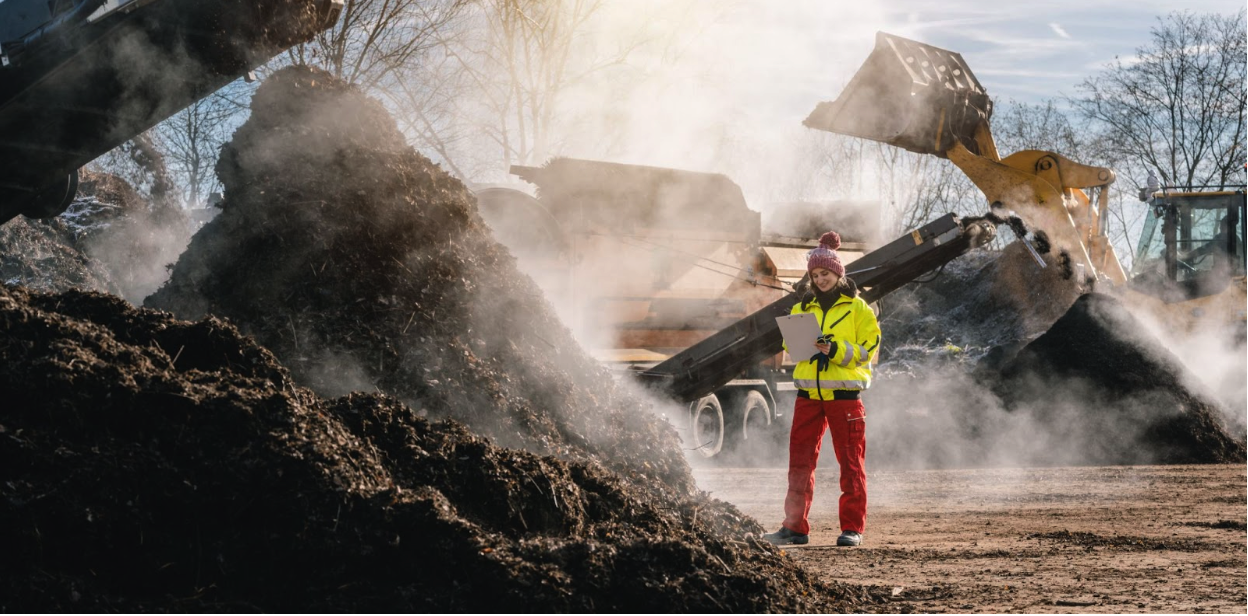Comparing Industrial and Backyard Composting: The Future of Sustainable Packaging Solutions
In recent years, compostable packaging solutions have gained popularity as a more sustainable alternative to traditional plastic packaging. Compostable materials are designed to biodegrade within a certain time frame under specific conditions. They are ideal for applications such as grains, cereals, snack foods, pet treats, cosmetics, personal care, home, health, beauty, tea, envelopes, and more. However, compostable solutions may not be suitable for all applications, and it is crucial to understand the differences between industrial and backyard composting to make informed decisions.
Industrial composting facilities are designed to handle large volumes of compostable materials, including yard waste, food scraps, and compostable packaging products. Image Courtesy: Envato Elements
EPR Laws on the Books
As the demand for more sustainable packaging grows, several states in the US have introduced Extended Producer Responsibility (EPR) laws to hold producers responsible for the environmental impacts of their products throughout their lifecycle. California State Bill 54, also known as the Plastic Pollution Prevention and Packaging Producer Responsibility Act, is one such legislation. This bill is part of a wider collection of EPR laws being proposed and passed in several other states, such as Maine's LD 1541, Oregon's SB 582, Washington's 70A.245, and Colorado's HB 22-1355. These laws aim to reduce the volume and toxicity of packaging waste entering landfills, increase recycling rates, and incentivize producers to use more sustainable packaging materials.
EPR laws require producers, through a Producer Responsibility Organization (PRO), to design, fund, and manage their products' recycling and waste management systems, thereby shifting the responsibility and cost from municipalities and citizens to the producers themselves. California's ambitious goal is to have all of its packaging be 100% recyclable or compostable by 2032, according to California State Bill 54.
To better understand how compostable packaging can contribute to these goals, it is essential to explore the differences between industrial and backyard composting processes.
Industrial composting facilities are designed to handle large volumes of compostable materials, including yard waste, food scraps, and compostable packaging products. Image Courtesy: Envato Elements
Industrial Composting Designs
Industrial composting facilities are designed to handle large volumes of compostable materials, including yard waste, food scraps, and compostable packaging products. The article "The Process of Industrial Composting" outlines two common methods used in industrial composting: windrow composting and aerated static composting. Both methods rely on proper aeration and moisture management, as well as the correct carbon-to-nitrogen ratio, to create ideal conditions for microbial activity.
In windrow composting, long piles of feedstock are turned by machines to promote aeration. On the other hand, aerated static composting utilizes ventilation fans to force air through the pile, eliminating the need for physical turning. The piles are monitored for temperature, moisture, oxygen, and porosity, contributing to the successful breakdown of compostable materials.
The YouTube video "Composting: How it Works and the Benefits" explains that once ideal conditions are achieved, microbes flourish, and the pile heats up to temperatures between 131 and 160 degrees Fahrenheit. This heat is crucial for killing weed seeds and potential pathogens and breaking down compostable products. The microbes consume the organic matter in the feedstock, aiding in the decomposition process. The result is a nutrient-rich soil that has a wide variety of applications.
How Backyard Composting Differs
When compared to industrial composting, backyard composting is a smaller-scale process in a homeowner's yard. While it is an effective way to recycle organic waste, it may not be as efficient or suitable for breaking down some compostable packaging materials. Image Courtesy: Envato Elements
When compared to industrial composting, backyard composting is a smaller-scale process in a homeowner's yard. While it is an effective way to recycle organic waste, it may not be as efficient or suitable for breaking down some compostable packaging materials. Image Courtesy: Envato Elements
Backyard composting, on the other hand, is a smaller-scale process in a homeowner's yard. While it is an effective way to recycle organic waste, it may not be as efficient or suitable for breaking down some compostable packaging materials. Backyard composting typically involves compost bins, tumblers, or piles and requires regular maintenance, such as turning and watering, to ensure proper decomposition.
A significant difference between industrial and backyard composting is the ability to reach and maintain high temperatures required for breaking down certain compostable materials, like compostable packaging. Industrial facilities are better equipped to achieve and maintain these temperatures consistently, ensuring proper decomposition of compostable materials. At the same time, backyard composting systems often struggle to reach the necessary temperatures for extended periods. As a result, some compostable packaging products may not break down effectively in backyard composting setups.
Another factor to consider is the time it takes for materials to decompose. Industrial composting facilities typically have a faster decomposition rate due to the controlled environment and optimal conditions. Backyard composting, on the other hand, can take longer for materials to break down, especially if conditions are not ideal. ASTM D6400 provides the guidelines for plastics and products made of plastic to make compostability claims for industrial or municipal compostability.
Despite these challenges, backyard composting still plays an essential role in waste reduction and offers numerous benefits, such as diverting organic waste from landfills, reducing greenhouse gas emissions, and providing natural fertilizer for gardens and landscapes. When choosing compostable packaging, it is crucial for consumers to understand the differences between industrial and backyard composting and select products that align with their composting capabilities.
Conclusion
In conclusion, compostable packaging solutions offer a promising alternative to traditional plastic packaging. However, it is important to recognize the differences between industrial and backyard composting processes and their ability to handle various compostable materials. As more states implement EPR laws and push for sustainable packaging solutions, understanding these differences will help producers, consumers, and policymakers make informed decisions about waste management strategies and the use of compostable packaging materials.
Enjoy this article? Let’s start a conversation! Reach out to us and explore what EarthGuard has to offer.


